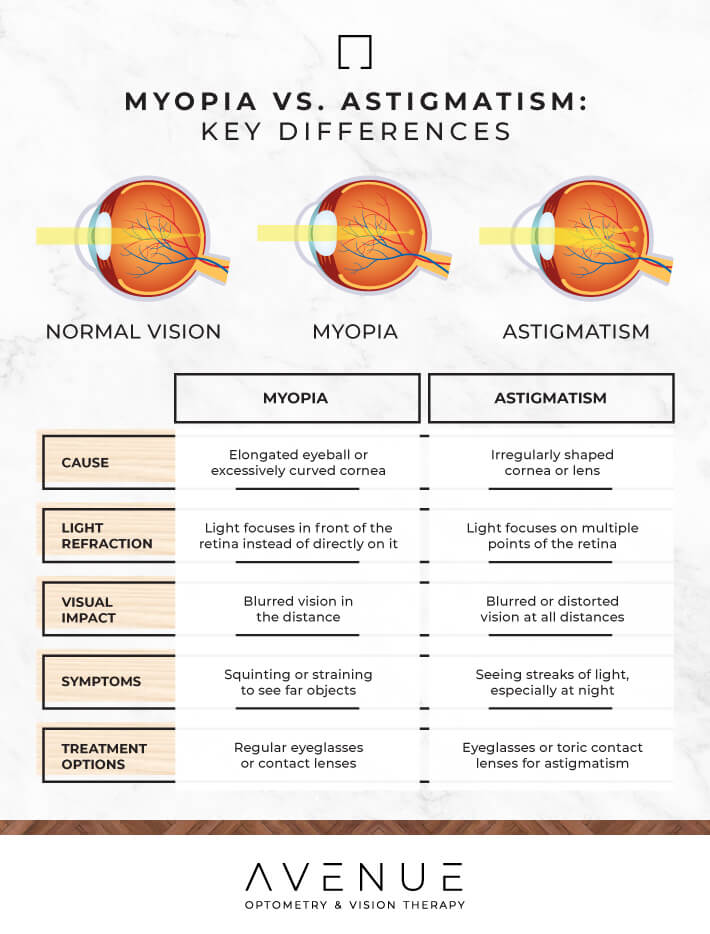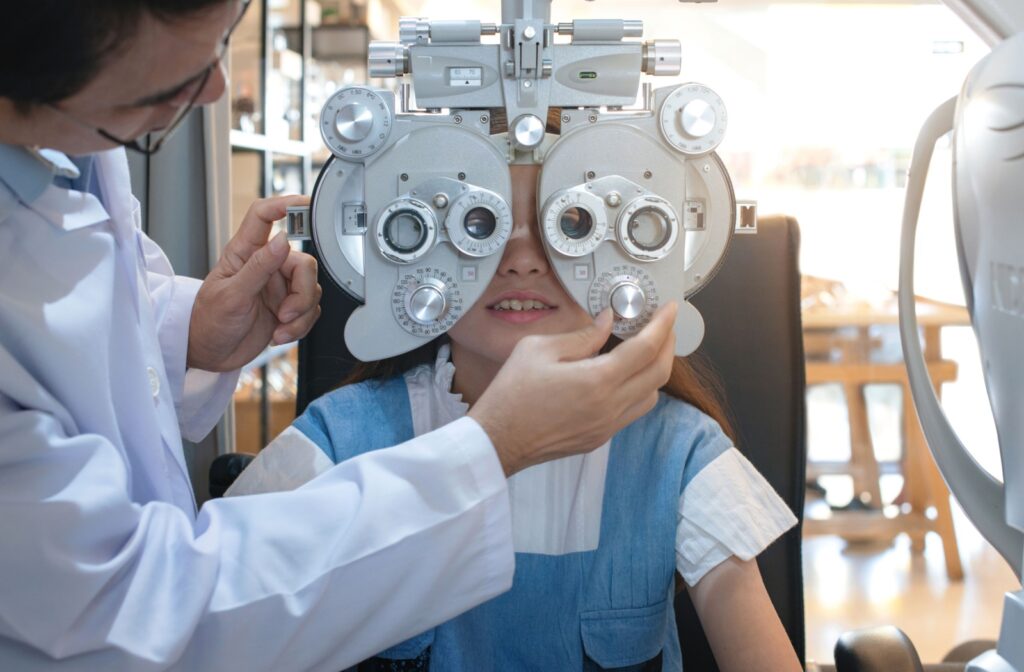Myopia and astigmatism both affect how your eyes focus light, but they are distinct refractive errors with different causes, symptoms, and treatment methods.
Your optometrist can assess your ocular health to help detect and address vision issues like refractive errors.
What Is Myopia?
Myopia, also known as nearsightedness, is a common refractive error that occurs when the eye is slightly longer than normal or when the cornea is too curved. This focuses light in front of the retina instead of directly on it, causing distant objects to appear blurry.
Myopia typically develops during childhood and may progress into the late teens or early adulthood.
What Is Astigmatism?
Astigmatism occurs when the cornea or the lens is slightly irregular or cylindrical instead of being round. Like myopia, this irregular shape affects how light refracts in your eye. While myopia causes blurry distance vision, astigmatism can cause blurred or distorted vision at all distances.

How Are Myopia & Astigmatism Different?
Both refractive errors affect vision and can even occur together, but they have distinct differences.
While myopia is caused by an elongated eyeball or excessively curved cornea, astigmatism is caused by an irregularly shaped cornea or lens.
Symptoms
Common symptoms of myopia include:
- Difficulty seeing road signs and distant objects
- Squinting or straining to see far away
- Sitting very close to screens or whiteboards
Common symptoms of astigmatism include:
- Blurred or distorted near and distance vision
- Difficulty seeing clearly at night
- Seeing streaks of lights, especially at night
Additionally, myopia and astigmatism can both cause headaches due to excessive eye strain. However, these symptoms don’t necessarily mean you have these refractive errors. A comprehensive eye exam can confirm whether you have refractive errors.
Prevalence
Myopia
In our digital world, we spend more time indoors looking at close work. As our eyes focus on near vision, our distance vision may weaken over time. The lack of outdoor time has been linked to the increasing rate of myopia, and myopia’s prevalence continues to increase.
A 2016 study estimates that, by 2050, up to 50% of the world will have myopia. Routine eye exams and encouraging outdoor activities can help preserve your child’s vision.
Astigmatism
Although both refractive errors are common, most people have some degree of astigmatism. Small amounts of astigmatism are normal and may not require treatment, but they can still affect vision.
Progression
Myopia usually develops in childhood and can progress until adulthood, potentially resulting in poor distant vision. The severity of myopia ranges, but any level impacts vision when left unaddressed. Specialty contact lenses and glasses can help slow myopia progression and preserve children’s eyesight.
Astigmatism, on the other hand, often stays stable. However, in rare cases, a condition called keratoconus can cause the cornea to become progressively cone-shaped, leading to a large amount of astigmatism, which requires specialized treatment methods.
Treatment Methods
Both myopia and astigmatism can be effectively managed with the help of your optometrist. After a comprehensive eye exam, they can help determine your prescription to correct refractive errors.
Myopia is easily corrected with eyeglasses and contact lenses. Your eye doctor can evaluate your sight to determine the specific lens power needed to correct your vision.
Astigmatism is corrected with special glasses that have cylindrical lenses, which can compensate for the irregular curvature of the cornea or lens. For people who prefer contact lenses, toric contact lenses are torus-shaped and designed specifically for astigmatism. Your eye doctor can assess the nature of your astigmatism and write a special prescription.

How Are Refractive Errors Detected?
A comprehensive eye exam can assess refractive errors. Your optometrist may conduct a series of specialized tests, such as:
- A visual acuity test: Using a standard eye chart, your optometrist evaluates how well you see at different distances. You may be asked to read letters while covering one eye at a time. This initial test can reveal refractive errors like myopia, astigmatism, and hyperopia (farsightedness).
- Corneal measurements: Your optometrist may measure the curvature of your cornea, which is especially important for astigmatism. These tests reveal irregularities in corneal shape and guide treatment options like specialized contact lenses.
- Refraction tests: Your optometrist uses a phoropter, which contains various lenses. Through the phoropter, you will look at an eye chart again while your optometrist switches between lenses, asking which ones make your vision clearer. The process helps pinpoint the exact level of your refractive error to fine-tune your prescription.
Take the First Step Toward Clearer, Healthier Vision
Healthy vision encompasses your sight and eye health. Unaddressed problems can affect your quality of life and lead to more serious eye issues in the future. Routine eye exams are the best way to identify and address refractive errors and other eye concerns.If you or your child experience blurry, distorted vision, contact our team at Avenue Optometry & Vision Therapy. We can help diagnose the issue and explore your treatment options.




